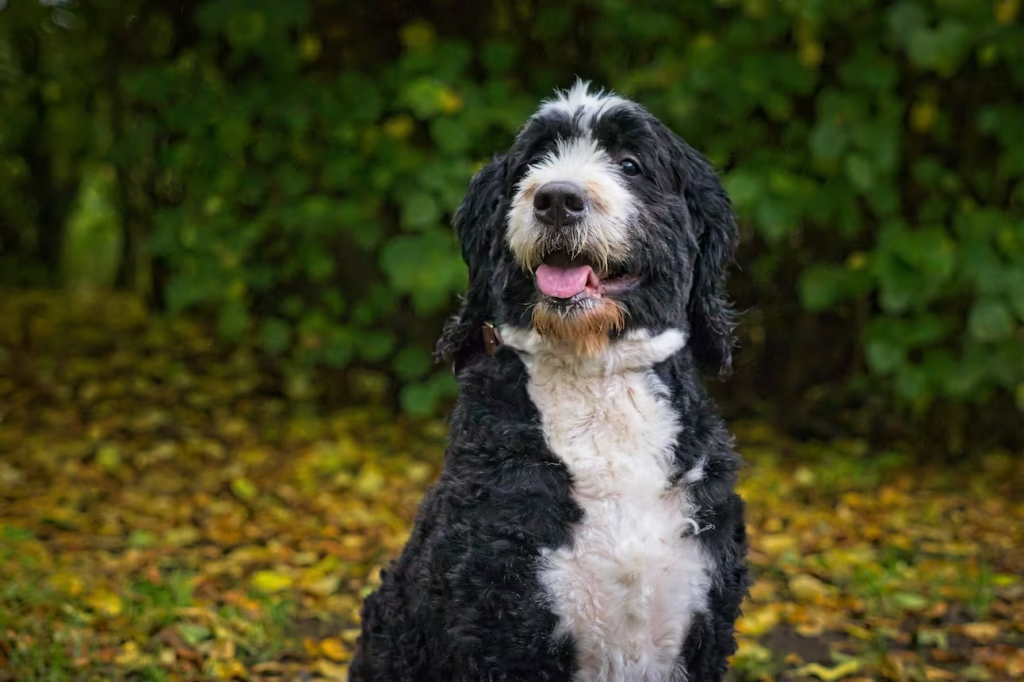The Bernedoodle is a hybrid breed that has become very popular with dog lovers around the world. It is a mix between the Bernese Mountain Dog and the Poodle, creating a dog that is intelligent, playful, and loyal, all wrapped in a fluffy and charming appearance. Whether you are thinking about getting a Bernedoodle or just learning more about the breed, this guide will provide all the information you need, covering their size, temperament, grooming, training, and health.
Learn more about: Cat tress

What Is a Bernedoodle?
The Bernedoodle is a relatively new type of “Doodle breed” created to blend the best qualities of two popular dogs, the loyal and gentle nature of the Bernese Mountain Dog, and the Poodle, which contributes qualities like low-shedding fur and exceptional intelligence.
Origin & History
The Bernedoodle breed was deliberately developed in 2003 by Sherry Rupke at SwissRidge Kennels. She aimed to create a perfect family dog, one that is smart, loving, and suitable for people with allergies. Although there might have been accidental breed crossings before that, Rupke’s work helped to make the breed more consistent and widely known.
Bernedoodle vs. Other Doodle Breeds
| Breed | Parentage | Personality Traits | Coat Type | Shedding |
|---|---|---|---|---|
| Bernedoodle | Bernese Mountain Dog × Poodle | Loyal, calm, goofy, sensitive | Wavy or curly | Low |
| Goldendoodle | Golden Retriever × Poodle | Outgoing, energetic, friendly | Curly or straight | Low |
| Labradoodle | Labrador Retriever × Poodle | Smart, playful, sociable | Wiry or curly | Moderate |
Bernedoodles are often more laid-back and family-centered than other Doodle breeds, which makes them a great choice for many households.
Bernedoodle Sizes & Types
The size of a Bernedoodle depends on the Poodle parent involved, generally classified into Toy, Miniature, or Standard size groups.
| Type | Weight Range | Height Range | Best For |
|---|---|---|---|
| Tiny Bernedoodle: | Weighs between 10 and 24 pounds | 12 to 17 inches | Apartment living or compact homes |
| Mini Bernedoodle | 25–49 lbs | 18–22 inches | Families, moderate exercise needs |
| Standard | 50–90 lbs | 23–29 inches | Active families, larger homes |
Generations Explained
- F1 Bernedoodle: 50% Bernese, 50% Poodle
- F1b Bernedoodle: 75% Poodle, 25% Bernese (more hypoallergenic)
- F2 Bernedoodle: Two Bernedoodle parents (more variation)
F1b Bernedoodles are often preferred by allergy sufferers due to their curly coats, which resemble those of Poodles.
Bernedoodle Temperament & Personality
Bernedoodles are famous for being loving, friendly, and easygoing companions. They form close connections with their owners and are excellent pets for families with kids.
Common Personality Traits:
- Loyal: They form strong connections with their owners.
- Playful: They enjoy playing and going outside.
- Sensitive: They can be affected by harsh training, so positive reinforcement is important.
- Goofy: Many people find them funny and silly.
Real Owner Quote: “Our Bernedoodle is like a big teddy bear who loves cuddles but also makes us laugh every day.”
They do best in homes where they are not left alone for long, as they can develop separation anxiety if they are neglected.
Grooming and Coat Care for Bernedoodles
Bernedoodles have different coat types, straight, wavy, or curly, depending on their genetics, which affects how much grooming they need.
Grooming Needs:
| Coat Type | Grooming Frequency | Shedding | Hypoallergenic |
|---|---|---|---|
| Curly | Brush daily, trim monthly | Very Low | Yes |
| Wavy | Brush 2–3 times/week | Low | Low Mildly |
| Straight | Weekly brushing | Moderate | No |
Tips:
- Professional grooming every 6–8 weeks is recommended.
- Consistent brushing helps avoid tangles and mats while maintaining a healthy, glossy coat.
- Clean their ears weekly to prevent infections.
Health and Lifespan of Bernedoodles
With the right care and lifestyle, Bernedoodles are typically healthy dogs and can live anywhere from 12 to 18 years, depending on their size.
Common Health Issues:
- Hip dysplasia
- Elbow dysplasia
- Progressive retinal atrophy
- Skin allergies
- Bloat (especially in larger types)
Lifespan by Size:
- Tiny: 15–18 years
- Mini: 14–17 years
- Standard: 12–15 years
Preventive care such as early health screenings, good quality food, and regular exercise can greatly improve their lifespan and overall well-being.
Training Tips for Bernedoodles
While Bernedoodles are generally eager to learn, they can occasionally show a stubborn streak passed down from their Bernese Mountain Dog lineage.
Training Best Practices:
- Start training from 8 to 10 weeks old.
- Use positive reinforcement, treats, praise, and play.
- Keep sessions short and fun.
- Socialize them with other dogs and people early.
Potty training and crate training are usually easier for Bernedoodles, especially in F1b types, due to their higher intelligence from the Poodle side.
Feeding a Bernedoodle: Nutrition and Diet
A Bernedoodle’s diet should be tailored according to its size and how active it is. It is important to feed them the right food for their joints, coat, and brain health.
Nutritional Needs:
| Life Stage | Meals/Day | Food Type |
|---|---|---|
| Puppy | 3–4 High-protein | DHA-rich |
| Adult | 2 Balanced | Protein, fat, fiber |
| Senior | 2 Low-calorie | Joint-supportive |
Avoid:
- Onions, garlic, and chocolate
- Overfeeding (they can gain weight quickly)
- Raw food unless approved by a vet
Look for foods that list real meat as the first ingredient, include omega-3s for coat health, and have glucosamine for joint support.
Exercise and Activity Needs of a Bernedoodle
Bernedoodles require regular physical and mental stimulation, but they do not need as much as a Border Collie or Husky.
Daily Needs:
- 45–90 minutes of activity per day
- Walks, playtime, training, and puzzle toys
- Space to move, backyard, or dog park
Tiny Bernedoodles need less exercise but still benefit from daily play and walks.
Bernedoodle Puppies – What to Know Before Adoption
Bringing home a Bernedoodle puppy is a big responsibility. Here is what you should know:
Choosing a Breeder:
- Look for breeders who test for health issues.
- Avoid puppy mills and pet stores.
- Ask for veterinary records and proof of early socialization.
Average Cost:
| Type | Price Range |
|---|---|
| Tiny | $3,000–$5,000 |
| Mini | $2,500–$4,500 |
| Standard | $2,000–$4,000 |
Puppy Prep Checklist:
- Crate and bedding
- High-quality puppy food
- Grooming tools
- Training treats and toys
- Vet appointment
Should You Get a Bernedoodle?
Pros:
- Friendly with kids and pets
- Hypoallergenic (mostly)
- Adaptable to different living situations
- Highly trainable
Cons:
- Requires frequent grooming
- Can suffer from separation anxiety
- Expensive to buy and maintain
Perfect For:
- Families
- Active individuals
- First-time dog owners (with time to train)
FAQs
A Generally not. They may bark when wearied or anxious, but are not known for being noisy.
Yes, especially F1b and coiled-coated Bernedoodles.
Sizes range from as small as 10 pounds (Tiny) up to 90 pounds (Standard).
With sufficient daily physical activity, both Mini and Tiny Bernedoodles are suitable for living in apartments.
A minimum to low shedding, depending on coat type.
Conclusion
The Bernedoodle is an amazing blend of the tender Bernese Mountain Dog and the intelligent Poodle, performing in a well-balanced, loving, and joyful companion. Whether you are looking for a hiking buddy, a lounge cuddler, or a playful family canine, the Bernedoodle can be a perfect match.
Their hypoallergenic coats, social personality, and adaptable nature make them one of the most desirable portrayals types. With proper care, early training, and lots of love, a Bernedoodle will be a pious and frothy member of your family for many years.


Pingback: Cat Paws: Anatomy, Care Tips & Fun Facts -